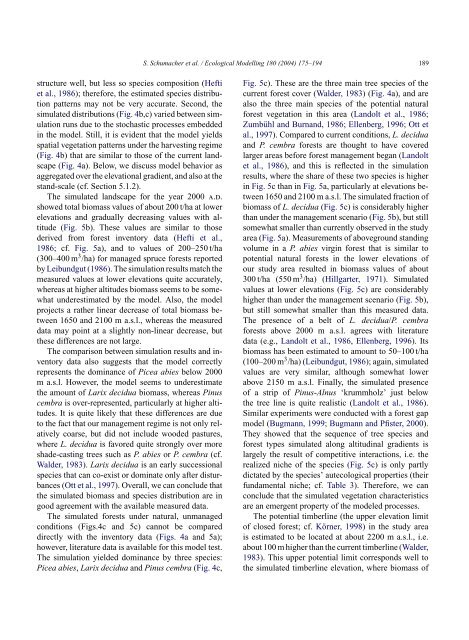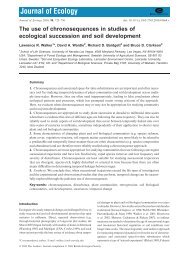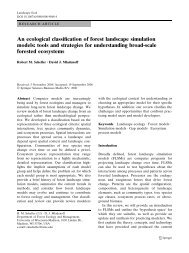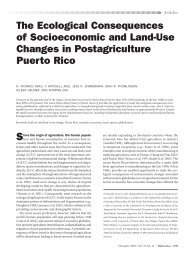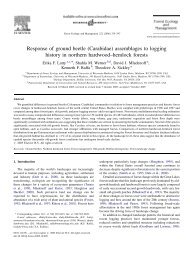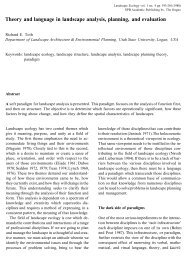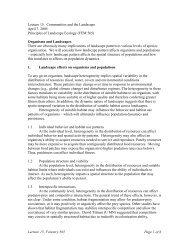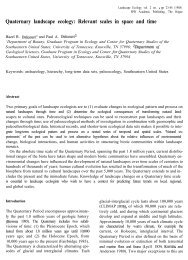Improving the formulation of tree growth and succession in a ...
Improving the formulation of tree growth and succession in a ...
Improving the formulation of tree growth and succession in a ...
Create successful ePaper yourself
Turn your PDF publications into a flip-book with our unique Google optimized e-Paper software.
S. Schumacher et al. / Ecological Modell<strong>in</strong>g 180 (2004) 175–194 189<br />
structure well, but less so species composition (Hefti<br />
et al., 1986); <strong>the</strong>refore, <strong>the</strong> estimated species distribution<br />
patterns may not be very accurate. Second, <strong>the</strong><br />
simulated distributions (Fig. 4b,c) varied between simulation<br />
runs due to <strong>the</strong> stochastic processes embedded<br />
<strong>in</strong> <strong>the</strong> model. Still, it is evident that <strong>the</strong> model yields<br />
spatial vegetation patterns under <strong>the</strong> harvest<strong>in</strong>g regime<br />
(Fig. 4b) that are similar to those <strong>of</strong> <strong>the</strong> current l<strong>and</strong>scape<br />
(Fig. 4a). Below, we discuss model behavior as<br />
aggregated over <strong>the</strong> elevational gradient, <strong>and</strong> also at <strong>the</strong><br />
st<strong>and</strong>-scale (cf. Section 5.1.2).<br />
The simulated l<strong>and</strong>scape for <strong>the</strong> year 2000 a.d.<br />
showed total biomass values <strong>of</strong> about 200 t/ha at lower<br />
elevations <strong>and</strong> gradually decreas<strong>in</strong>g values with altitude<br />
(Fig. 5b). These values are similar to those<br />
derived from forest <strong>in</strong>ventory data (Hefti et al.,<br />
1986; cf. Fig. 5a), <strong>and</strong> to values <strong>of</strong> 200–250 t/ha<br />
(300–400 m 3 /ha) for managed spruce forests reported<br />
by Leibundgut (1986). The simulation results match <strong>the</strong><br />
measured values at lower elevations quite accurately,<br />
whereas at higher altitudes biomass seems to be somewhat<br />
underestimated by <strong>the</strong> model. Also, <strong>the</strong> model<br />
projects a ra<strong>the</strong>r l<strong>in</strong>ear decrease <strong>of</strong> total biomass between<br />
1650 <strong>and</strong> 2100 m a.s.l., whereas <strong>the</strong> measured<br />
data may po<strong>in</strong>t at a slightly non-l<strong>in</strong>ear decrease, but<br />
<strong>the</strong>se differences are not large.<br />
The comparison between simulation results <strong>and</strong> <strong>in</strong>ventory<br />
data also suggests that <strong>the</strong> model correctly<br />
represents <strong>the</strong> dom<strong>in</strong>ance <strong>of</strong> Picea abies below 2000<br />
m a.s.l. However, <strong>the</strong> model seems to underestimate<br />
<strong>the</strong> amount <strong>of</strong> Larix decidua biomass, whereas P<strong>in</strong>us<br />
cembra is over-represented, particularly at higher altitudes.<br />
It is quite likely that <strong>the</strong>se differences are due<br />
to <strong>the</strong> fact that our management regime is not only relatively<br />
coarse, but did not <strong>in</strong>clude wooded pastures,<br />
where L. decidua is favored quite strongly over more<br />
shade-cast<strong>in</strong>g <strong>tree</strong>s such as P. abies or P. cembra (cf.<br />
Walder, 1983). Larix decidua is an early <strong>succession</strong>al<br />
species that can co-exist or dom<strong>in</strong>ate only after disturbances<br />
(Ott et al., 1997). Overall, we can conclude that<br />
<strong>the</strong> simulated biomass <strong>and</strong> species distribution are <strong>in</strong><br />
good agreement with <strong>the</strong> available measured data.<br />
The simulated forests under natural, unmanaged<br />
conditions (Figs.4c <strong>and</strong> 5c) cannot be compared<br />
directly with <strong>the</strong> <strong>in</strong>ventory data (Figs. 4a <strong>and</strong> 5a);<br />
however, literature data is available for this model test.<br />
The simulation yielded dom<strong>in</strong>ance by three species:<br />
Picea abies, Larix decidua <strong>and</strong> P<strong>in</strong>us cembra (Fig. 4c,<br />
Fig. 5c). These are <strong>the</strong> three ma<strong>in</strong> <strong>tree</strong> species <strong>of</strong> <strong>the</strong><br />
current forest cover (Walder, 1983) (Fig. 4a), <strong>and</strong> are<br />
also <strong>the</strong> three ma<strong>in</strong> species <strong>of</strong> <strong>the</strong> potential natural<br />
forest vegetation <strong>in</strong> this area (L<strong>and</strong>olt et al., 1986;<br />
Zumbühl <strong>and</strong> Burn<strong>and</strong>, 1986; Ellenberg, 1996; Ott et<br />
al., 1997). Compared to current conditions, L. decidua<br />
<strong>and</strong> P. cembra forests are thought to have covered<br />
larger areas before forest management began (L<strong>and</strong>olt<br />
et al., 1986), <strong>and</strong> this is reflected <strong>in</strong> <strong>the</strong> simulation<br />
results, where <strong>the</strong> share <strong>of</strong> <strong>the</strong>se two species is higher<br />
<strong>in</strong> Fig. 5c than <strong>in</strong> Fig. 5a, particularly at elevations between<br />
1650 <strong>and</strong> 2100 m a.s.l. The simulated fraction <strong>of</strong><br />
biomass <strong>of</strong> L. decidua (Fig. 5c) is considerably higher<br />
than under <strong>the</strong> management scenario (Fig. 5b), but still<br />
somewhat smaller than currently observed <strong>in</strong> <strong>the</strong> study<br />
area (Fig. 5a). Measurements <strong>of</strong> aboveground st<strong>and</strong><strong>in</strong>g<br />
volume <strong>in</strong> a P. abies virg<strong>in</strong> forest that is similar to<br />
potential natural forests <strong>in</strong> <strong>the</strong> lower elevations <strong>of</strong><br />
our study area resulted <strong>in</strong> biomass values <strong>of</strong> about<br />
300 t/ha (550 m 3 /ha) (Hillgarter, 1971). Simulated<br />
values at lower elevations (Fig. 5c) are considerably<br />
higher than under <strong>the</strong> management scenario (Fig. 5b),<br />
but still somewhat smaller than this measured data.<br />
The presence <strong>of</strong> a belt <strong>of</strong> L. decidua/P. cembra<br />
forests above 2000 m a.s.l. agrees with literature<br />
data (e.g., L<strong>and</strong>olt et al., 1986, Ellenberg, 1996). Its<br />
biomass has been estimated to amount to 50–100 t/ha<br />
(100–200 m 3 /ha) (Leibundgut, 1986); aga<strong>in</strong>, simulated<br />
values are very similar, although somewhat lower<br />
above 2150 m a.s.l. F<strong>in</strong>ally, <strong>the</strong> simulated presence<br />
<strong>of</strong> a strip <strong>of</strong> P<strong>in</strong>us-Alnus ‘krummholz’ just below<br />
<strong>the</strong> <strong>tree</strong> l<strong>in</strong>e is quite realistic (L<strong>and</strong>olt et al., 1986).<br />
Similar experiments were conducted with a forest gap<br />
model (Bugmann, 1999; Bugmann <strong>and</strong> Pfister, 2000).<br />
They showed that <strong>the</strong> sequence <strong>of</strong> <strong>tree</strong> species <strong>and</strong><br />
forest types simulated along altitud<strong>in</strong>al gradients is<br />
largely <strong>the</strong> result <strong>of</strong> competitive <strong>in</strong>teractions, i.e. <strong>the</strong><br />
realized niche <strong>of</strong> <strong>the</strong> species (Fig. 5c) is only partly<br />
dictated by <strong>the</strong> species’ autecological properties (<strong>the</strong>ir<br />
fundamental niche; cf. Table 3). Therefore, we can<br />
conclude that <strong>the</strong> simulated vegetation characteristics<br />
are an emergent property <strong>of</strong> <strong>the</strong> modeled processes.<br />
The potential timberl<strong>in</strong>e (<strong>the</strong> upper elevation limit<br />
<strong>of</strong> closed forest; cf. Körner, 1998) <strong>in</strong> <strong>the</strong> study area<br />
is estimated to be located at about 2200 m a.s.l., i.e.<br />
about 100 m higher than <strong>the</strong> current timberl<strong>in</strong>e (Walder,<br />
1983). This upper potential limit corresponds well to<br />
<strong>the</strong> simulated timberl<strong>in</strong>e elevation, where biomass <strong>of</strong>


